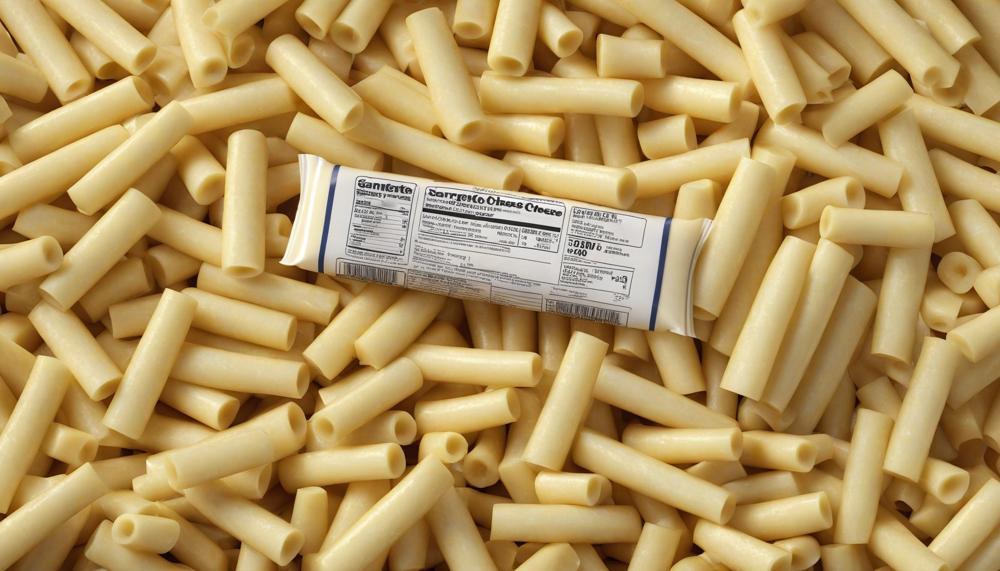Yes, you can eat expired Sargento string cheese, but it comes with some caveats. String cheese, including Sargento’s, has a relatively long shelf life thanks to its packaging and moisture content. If stored properly, it may be safe to consume even past the expiration date.
However, it’s crucial to consider storage conditions and be on the lookout for signs of spoilage.
Here’s what you need to know:
- Storage Matters: Proper storage is key. Keep string cheese refrigerated and in its original packaging until ready to use.
- Spoilage Indicators: Check for visual and sensory signs like mold, off-odors, or changes in texture. If any of these are present, it’s best to discard the cheese.
- Freezing Option: Freezing can extend its shelf life, but the quality may decline after about two months.
- Once Opened: After opening, consume the cheese within a week for optimal quality and safety.
- Safe for Cooking: If it’s just slightly past the expiration date and shows no spoilage signs, it can be used in thoroughly cooked dishes like grilled cheese or casseroles.
By paying attention to these factors, you can make a more informed decision on whether to consume your expired Sargento string cheese. Keep reading to dive deeper into the specifics of storage, spoilage signs, and safety tips to ensure you get the most out of your cheese.
Contents
- 1 Understanding Cheese Expiration
- 2 Safe Storage Practices
- 3 Identifying Spoiled String Cheese
- 4 Consumption and Safety Measures
- 5 Nutritional Aspect of String Cheese
- 6 Cheese Varieties and Expiry
- 7 Practical Tips and Tricks
- 8 Is it Safe to Eat Moldy Arnold Bread?
- 9 Is It Safe to Eat Undercooked Near East Couscous?
- 10 Conclusion
Understanding Cheese Expiration
Several factors contribute to the expiration of cheese, affecting its safety and quality:
Type of Cheese:
- Hard cheeses like cheddar and parmesan have lower moisture content, making them last longer.
- Soft cheeses such as brie and ricotta spoil faster due to higher moisture levels.
Storage Conditions:
- Temperature is crucial; cheese should be kept consistently cold.
- Humidity levels also play a role; cheese needs to be stored in conditions that balance moisture to prevent drying out or excessive moisture leading to mold.
Packaging:
- Proper packaging can extend shelf life. Vacuum-sealed packaging prevents exposure to air and contaminants.
- Once opened, cheese should be tightly wrapped in wax paper or plastic wrap and kept in an airtight container.
Handling:
- Avoid cross-contamination by using clean utensils when handling cheese.
- Frequent opening and closing of the packaging can introduce bacteria and spoilage agents.
Determining if Sargento String Cheese has gone bad involves checking for several spoilage signs:
- Mold: Any visible mold growth on string cheese is a clear indicator of spoilage.
- Smell: Off or sour odors indicate bacterial growth and spoilage.
- Texture: Changes in texture, such as excessive dryness, sliminess, or stickiness, suggest the cheese has deteriorated.
Here are some practical guidelines for checking Sargento String Cheese:
| Factor | Indicator | Action |
| Mold | Visible spots of mold | Discard the cheese |
| Smell | Off, sour, or ammonia-like odor | Discard the cheese |
| Texture | Unusual dryness, sliminess, or stickiness | Discard the cheese |
| Expiration Date | Beyond the printed date but no signs of spoilage | Use caution; if unsure, discard |
Proper storage and vigilance can ensure that string cheese remains safe and enjoyable for consumption.
Safe Storage Practices
To ensure the longevity and safety of Sargento String Cheese, follow these key safe storage practices:
- Refrigeration: Store Sargento String Cheese in the refrigerator at temperatures between 35-45℉ (1.7-7.2℃) to slow bacterial growth and maintain freshness.
- Original Packaging: Keep the cheese in its original packaging until you’re ready to eat it. This packaging is designed to provide optimal protection.
- Re-wrapping: After opening, re-wrap the cheese using cheese paper, wax paper, or parchment paper. This helps control moisture and allows the cheese to breathe, preventing mold growth.
- Airtight Containers: Place the wrapped cheese in an airtight container or use a vacuum sealer to minimize air exposure, which can extend the shelf life.
- Cleanliness: Always use clean hands and utensils when handling the cheese to prevent contamination. This helps maintain the quality and safety of the cheese.
- Freshness Monitoring: Regularly check for signs of spoilage, such as mold, off smells, or changes in texture. Discard any cheese that shows these signs.
- Freezing: For longer storage, you can freeze Sargento String Cheese. Wrap it tightly in plastic wrap, then place it in a freezer bag to prevent freezer burn. Thaw in the refrigerator before use.

Identifying Spoiled String Cheese
To identify spoiled Sargento string cheese and ensure it’s safe and fresh to eat, follow these guidelines:
Visual Inspection:
- Mold: Look for any mold growth. Mold appears as blue, green, or white fuzzy patches.
- Discoloration: Fresh string cheese should be a uniform light creamy color. Any dark spots or yellowing are signs of spoilage.
Smell Test:
- Off Odors: Spoiled cheese emits sour or ammonia-like smells. Fresh cheese should have a mild, milky scent.
Texture Examination:
- Consistency: Check if the cheese is crumbly or has an unusual texture. Fresh cheese should be firm but pliable.
Proper Storage:
- Unopened Cheese: Store between 34°F and 40°F in its original packaging to prevent contamination.
- Opened Cheese: Consume within a week or store in an airtight container to avoid drying out and absorbing odors.
Expiry Date:
- Use-By Date: Always consider the use-by date. If the cheese is past this date, inspect it thoroughly.
- Food Poisoning Risk: Expired cheese can harbor bacteria like Listeria or Salmonella. If in doubt, discard it.
Cooking:
- Slightly Expired Cheese: Cooking slightly expired cheese thoroughly can eliminate harmful bacteria. Use it in cooked dishes like grilled cheese sandwiches for safer consumption.
Consumption and Safety Measures
When it comes to consuming expired Sargento String Cheese, there are several crucial safety measures to consider:
Visual and Sensory Inspection:
- Mold: Check for any visible mold on the cheese. Even small spots can indicate spoilage.
- Odor: Smell the cheese for any off or sour odors, which are clear signs of spoilage.
- Texture: Feel the texture. If it’s slimy or excessively hard, it’s likely unsafe to eat.
Storage Conditions:
- Unopened Cheese: Keep it in the fridge at a consistent temperature between 34°F and 40°F. Proper refrigeration slows bacterial growth.
- Opened Cheese: Once opened, wrap the cheese tightly in plastic wrap or store it in an airtight container to minimize exposure to air and humidity, which can speed up spoilage.
Timing:
- Consumption Timeline: After opening, consume the cheese within a week for best quality and safety.
- Expiry Date: If the cheese is slightly past the expiration date but shows no signs of spoilage, it might still be usable, especially if cooked thoroughly.
Cooking Considerations:
- Heating: Using slightly expired cheese in cooked dishes can reduce the risk of foodborne illness, as cooking can kill many harmful bacteria.
Potential Risks:
- Bacterial Contamination: Expired string cheese can harbor harmful bacteria like Listeria and Salmonella, which can cause serious food poisoning.
- Allergic Reactions: Moldy cheese can trigger allergic reactions and respiratory issues in sensitive individuals.
Nutritional Integrity:
- Decline Over Time: The nutritional value of string cheese diminishes past its expiration date, so fresher cheese is generally healthier.
Nutritional Aspect of String Cheese
The short answer: String cheese is a nutrient-rich snack, but its nutritional value can degrade over time, particularly after the expiration date.
String cheese offers several nutritional benefits:
- Protein: Each 28g serving provides around 6-7g of protein, essential for muscle repair and growth.
- Fat: Contains beneficial fats that help in the absorption of vitamins.
- Vitamins and Minerals: It’s a good source of calcium and vitamin D, crucial for bone health.
However, there are key considerations regarding its expiration date:
- Freshness and Safety: Consuming string cheese past its expiration date can be risky. Over time, the cheese can develop harmful bacteria, especially if not stored properly.
- Quality Degradation: Nutritional quality may diminish. Proteins can break down, and fats can go rancid, impacting both taste and nutritional value.
To maintain its nutritional benefits, always store string cheese in the refrigerator and use it before the expiration date. Avoid any cheese that has been at room temperature for more than 2 hours or shows signs of spoilage, such as mold or off odors.
| Nutrient | Amount per 28g Serving | Benefit |
| Calories | 85 | Provides energy |
| Protein | 6-7g | Muscle repair and growth |
| Fat | 5-6g | Helps in vitamin absorption |
| Calcium | 200mg | Bone health |
| Vitamin D | 0.2µg | Bone health and immune support |
Cheese Varieties and Expiry
| Cheese Variety | Signs of Expiry | Details |
| Cheddar | Mold, sour smell, dryness | Hard cheese, typically lasts longer, may develop a hard rind but remains edible if mold is removed. |
| Parmesan | Ammonia-like odor, unusual mold | Very hard cheese, can last for months. Store properly to prevent spoilage. Black mold is a clear indicator of expiration. |
| Brie | Sliminess, strong ammonia smell, discoloration | Soft cheese, more prone to spoilage. Check for changes in texture and smell. |
| Mozzarella | Sliminess, sour smell | Fresh cheese, short shelf life. Should be consumed quickly after opening. |
| Blue Cheese | Excessive mold, off smell | Already moldy by nature, but look for unusual colors and smells. If the taste is off, discard it. |
Practical Tips and Tricks
Check the Expiration Date
- The first step is to look at the expiration date on the packaging. However, remember that this is just a guideline for peak quality.
Visual Inspection
- Mold: If you see any mold, it’s time to toss the cheese. Mold can appear as green, blue, or white spots.
- Discoloration: Fresh string cheese should be a uniform colour. If it has turned yellow or has dark spots, it is likely spoiled.
Smell Test
- Off-Odor: Fresh string cheese should have a mild, milky scent. If it smells sour, rancid, or has a strong off-odor, do not eat it.
Texture Check
- Sliminess: If the cheese feels slimy or sticky, it is likely past its prime.
- Hardness: Fresh string cheese should be firm but pliable. If it has become hard and brittle, it’s time to discard it.
Storage Conditions
- Refrigeration: Keep the cheese consistently refrigerated at or below 40°F (4°C). Ensure it’s well-wrapped to prevent exposure to air.
- Freezing: For longer storage, string cheese can be frozen. However, consume within two months for best quality.
Taste Test
- Taste Change: If it tastes sour or different from its usual mild flavor, it’s safer to avoid consuming it.
Packaging Integrity
- Check Seals: If the packaging is damaged or the seal is broken before opening, the cheese may be compromised.
Consider Cooking
- Thorough Cooking: If the cheese is slightly past its expiration but shows no spoilage signs, consider using it in thoroughly cooked dishes like casseroles or melted on a sandwich to ensure any potential bacteria are killed.
Is it Safe to Eat Moldy Arnold Bread?
No, it is not safe to eat moldy Arnold bread. Experts strongly advise against consuming bread that has visible mold, as well as attempting to cut away the moldy sections and eating the rest.
- Health Risks: Mold can produce harmful toxins, known as mycotoxins, which may not be visible to the naked eye. These toxins can cause adverse health effects, including allergic reactions and respiratory issues.
- Widespread Contamination: Mold spores can spread throughout the entire loaf of bread, not just the visibly affected parts. This means that even if you remove the moldy sections, the remaining bread may still contain harmful spores.
- Expert Advice: Food microbiologists and health experts caution against eating any bread that shows signs of mold growth. The risk of ingesting harmful toxins is too great, making it safer to discard the entire loaf.
Is It Safe to Eat Undercooked Near East Couscous?
The short answer is no, it is not safe to eat undercooked Near East couscous.
Undercooked couscous can present several issues, primarily due to potential bacterial contamination. When couscous is not properly cooked, it may not reach a temperature high enough to kill harmful bacteria that could be present. Even though the risks are not as high as with undercooked meat or eggs, consuming undercooked couscous can still pose health risks.
Proper Cooking Guidelines:
To ensure your Near East couscous is safe to eat, follow these steps:
- Boiling Water: Use the standard ratio of 1 cup of water to 2/3 cup of couscous.
- Cooking Time: After bringing the water to a boil, stir in the couscous, cover, and remove from heat. Let it stand for 5 minutes to allow the couscous to absorb the water and cook properly.
- Fluffing: After the standing time, fluff the couscous with a fork to ensure it’s light and fluffy.
Refrigeration:
After cooking, couscous should be refrigerated within two hours. Store it in an airtight container to keep it fresh and safe for up to 3-5 days.
Cooking Safety Tips:
| Step | Action | Reason |
| Boil Water | 1 cup water to 2/3 cup couscous | Ensure proper absorption and cooking |
| Stir and Cover | Remove from heat, let stand for 5 minutes | Allow couscous to absorb water and cook fully |
| Fluff with Fork | After standing time | Ensure light, fluffy texture |
| Refrigerate | Within 2 hours | Prevent bacterial growth |
To enjoy Near East couscous safely, make sure to follow the recommended cooking instructions on the packaging. Properly cooked couscous should be tender, light, and fluffy, without any hard, grainy parts.
Conclusion
Eating expired Sargento string cheese isn’t necessarily a no-go, but it does require some caution. String cheese has a fairly long shelf life, but its safety hinges on proper storage and the absence of spoilage signs.
Key Considerations:
- Storage: Always refrigerate string cheese in its original packaging. Once opened, consume within a week for the best quality.
- Spoilage Signs: Look out for mold, off-odors, and texture changes. Mold or a sour smell means it’s time to toss it. Fresh cheese should be firm but pliable.
- Freezing: You can freeze string cheese to extend its life, but keep in mind that quality may decrease after a couple of months.
- Cooking with Expired Cheese: If it’s just slightly past the expiration date and doesn’t show spoilage signs, using it in cooked dishes like casseroles or grilled cheese sandwiches can be safe. Cooking can kill many harmful bacteria.
- Health Risks: Consuming spoiled cheese can lead to foodborne illnesses caused by bacteria such as Listeria or Salmonella. Always err on the side of caution if you’re unsure.




